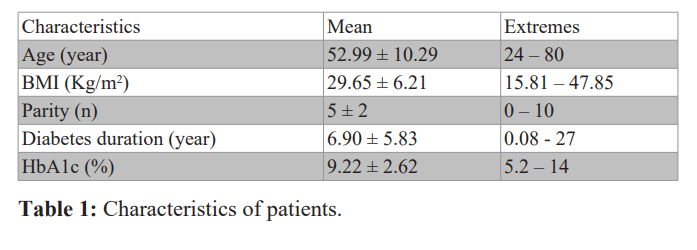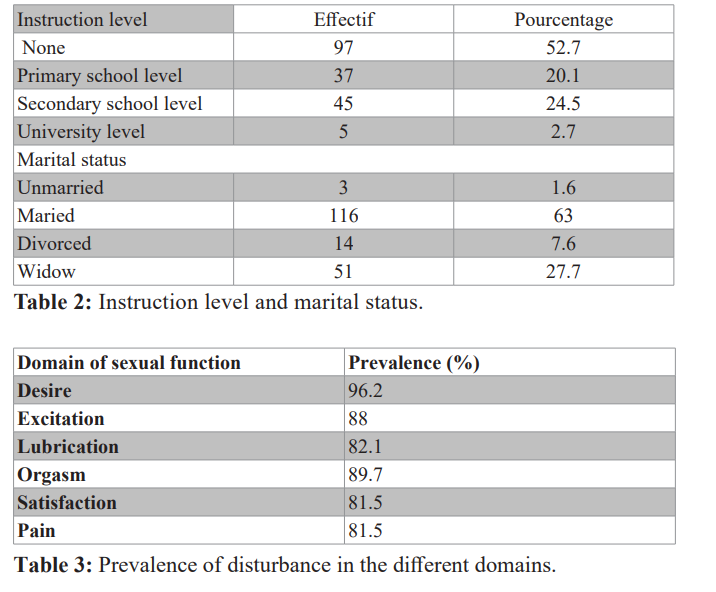Sexual Dysfunction in Women with Diabetes: Prevalence and Associated Factors in The Diabetes Center in Cotonou - Benin
Author(s): Djrolo F*, Gninkoun CJ, Gbessoua ML, Hounnou M, and Fanou J
Département de Médecine Interne, Unité d’Endocrinologie Métabolisme Nutrition, Faculté des Sciences de la Santé, BP 188 Cotonou, Benin.
*Correspondence:
François Djrolo, Département de Médecine Interne, Unité d’Endocrinologie Métabolisme Nutrition, Faculté des Sciences de la Santé, BP 188 Cotonou, Benin.
Received: 26 November 2020 Accepted: 01 January 2021
Citation: Djrolo F, Gninkoun CJ, Gbessoua ML, et al. Sexual Dysfunction in Women with Diabetes: Prevalence and Associated Factors in The Diabetes Center in Cotonou – Benin. Diabetes Complications. 2021; 5(1); 1-4.
Abstract
Diabetic complications occur in both sexes but impaired sexual function in people with diabetes, largely debated in men, is less documented in women.
Objective: The aim of the study was to evaluate the prevalence of sexual dysfunction in women with diabetes and to investigate associated factors.
Patients and Methods: In a cross-sectional study, Women living with diabetes attending the outpatient diabetes center of Cotonou completed the validated questionnaires of the Female Sexual Function Index. After clinical examination, Medical records of patients were consulted to complete information on the diabetes, its control and complications. Square Chi test was used for statistical analysis. Difference observed were considered significant for p<0.05.
Results: A total of 184 women with diabetes were included in the study. Mean age of patients was 52.9 ± 10.3 years with extremes of 24 and 80 years. The mean duration of the diabetes was 6.9 ± 5.8 years (extremes: one month and 27 years.
The prevalence of sexual dysfunction was 84.2% (155/184).
Factors associated with high prevalence of sexual dysfunction were age of patient higher or equal to 50 years (p=0.003), low instruction level (p=0.03), low monthly income (p=0.04), Parity or gestity higher or equal to 4 (p=0.01), high blood pressure (p=0.0001), the presence of neuropathy (p=0.013), diabetes duration higher or equal to 5 years (p=0.007).
There was no association of sexual dysfunction with body mass index or with central obesity.
In multivariate analysis, only diabetes duration and gestity remained significantly associated with sexual dysfunction.
Conclusion: Sexual function impairment is very frequent in women with diabetes but not often investigated. It can constitute a major cause of alteration of quality of life. More attention must be paid to this condition in clinical practice.
Keywords
Introduction
Diabetes mellitus is a condition with persistent metabolic disorders that lead to a numerous of chronic complications of wich, some are largely studied like cardiovascular and neurological complications [1-3]. Sexual dysfunction is a well known complication of diabetes that involves in its mechanism, both neurological and vascular complications [4,5].
Sexual dysfunction occurs in both sexes. Erectile dysfunction is largely studied in men with diabetes [6-9] but very few studies had been devoted to sexual dysfunction in women with diabetes, particularly in Subsaharian Africa. The present study aimed to evaluate the prevalence of sexual dysfunction in women with diabetes and to investigate factors associated with this condition.
Patients and Method
The study population was constitued by women with diabetes attending the diabetes center of Cotonou, the main town of Benin. It was a crossectional study with a prospective data collection. Sexual function was assessed using the Female Sexual Function Index (FSFI) [10]. The domains assessed in sexual function were desire, arousal, lubrication, orgasm, satisfaction and pain. Factors investigated regarding patients were: age of patients, diabetes duration and complications, gestity, the menopausal status, instruction level, the presence of neuropathy and the presence of high blood pressure.
As psychological status is an important factor that influences sexual function, anxiodepressive status of patients was assessed using the Hospital Anxiety and Depression Scale (HADS) [8]. Chi square test and the student test were used for statistical analysis. The study design was approuved by the ethic comity of the faculty of health sciences.
Results
A total of 184 women with diabetes were included in the study. Characteristics of patients were shown in table 1.
From these 184 women with diabetes, 149 (81%) were menopaused and 175 (95.1%) presented type 2 diabetes. Instruction level and marital status of patients were presented in (Table 2).
Prevalence of sexual dysfunction
In the 184 women with diabetes included in the study, sexual dysfunction was detected in 155 making a prevalence rate of 84.2%. The frequency of disturbance observed in the different domains of sexual function investgated is shown in (Table 3).
It can be noted that women with diabetes presented a very high prevalence rate of sexual dysfunction.



Factors associated with sexual dysfunction in women with diabetes is presented in (Table 4).
As shown in this table, many factors were significantly associated with high prevalence of sexual dysfunction in women with diabetes, espacially, the age of patient, the parity of the woman, the presence of high blood pressure or peripheral neuropathy, diabetes duration and the presence of depressive status.
In multivariated analysis, only diabetes duration above five years, gestity higher or equal to 4, the presence of depressive status or severe anxiety remained significantly associated with sexual dysfunction in women with diabetes.

Discussion
Mean age of women included in this study was 53 ± 10.3 years which is closed to the mean age of 54.4 ± 9.8 years and 57.9 ± 6.9 years reported respectvely by Shadman et al. and Esposito et al. [11,12]. Prevalence of sexual dysfunction was very high in our study (84.2%). High prevalence of sexual dysfunction has been reported in women with diabetes by several authors : 88% for Ogbera et al. [13], 79.2% for Shi et al. [14], 94.4% for Shadman et al. [11], 75% for Nowoelski et al. [15] and 88% for Ziaei-Rad et al. [16]. On the other hand less high prevalence rate of 59.6% has been reported by Abu Ali et al. [17]. Regarding domains of sexual function explored, all domains of sexual function were affected in our study with a high prevalence rate. For Erol et al. [18], most affected domains were desire (77%), excitation (62.5%), and orgasm (49%) when Elyasi et al. [19] reported that the most affected domains were respctively lubrication, desire, excitation, pains and satisfaction.
As reported in some other studies [11,20-22], the lower instruction level was, the higher was the prevalence rate of sexual dysfunction in women with diabetes in the present study. We observed that Sexual dysfunction was also associated with monthly income in women with diabetes in our study. The same observation was made by Lewis [23] conversly to what has been reported by Duman [24]. As it can be espected and conformly to several reports [17,25], sexual dysfunction was significantly associated with disease duration. Surprisingly, there was no association of diabetes control and sexual dysfunction in our study. This can be explaned by the small size of the study population. We found also that sexual dysfunction was associated with peripheral neuropathy, anxiety and depression as reported by Elyasi et al. [19]. As reported by Doumas et al. [26] and Valdares et al. [27] the present work shown an association between high blood pressure and high prevalence of sexual dysfunction in women with diabetes. This observation is not surprising since erectile dysfunction has been demontrated as cardiovascular risk factor in men with diabetes.
Conclusion
In this study a very high prevalence of sexual dysfunction has been demonsrated in women with diabetes in Cotonou. Other studies in other areas had reported a similar observation. This condition can have a negative impact on quality of life but because of it’s taboo status patients did not complain of it. So, to inhence the screenig of this condition, sexual dysfunction must be systematicaly investiated in clinical practice.
References
- Jude EB, Oyibo SO, Chalmers N, et al. Peripheral arterial disease in diabetic and nondiabetic patients a comparison of severity and Diabetes Care. 2001; 24: 1433-1437.
- Tesfaye S, Selvarajah Advances in epidémiology pathogenesis and management of diabetic peripheral neuropathy. Diabetes Metabolism Research and Reviews. 2012; 28: 8-14.
- Valensi P. Dysautonomie du diabète détection et prise en La lettre du Neurologue. 2012; 4: 144.
- Selihi Z, Berrahu M, Rhazi EL. Etude des fréquences type et déterminants des complications dégénératives du diabète de type 2. Revue d’épidémiologie et de Santé Publique. 2014; 62: 187-290.
- Ferritti L. Dysfonction érectile un marqueur précoce de l’état Cardiologie cardinale. 2014; 8: 54-62.
- Tiv P, Tiv M, Druet C. Dysfonction érectile chez les patients diabétiques en France. Diabetes and Metabolism. 2014; 40: 23-34.
- Arar Dysfonction érectile et diabète Résultat d’une enquête prospective à Oran. Diabetes and Metabolism. 36: 68-69.
- Lokrou A, Koffi DP, Soumahoro S, et Etude épidémiologique et clinique de la dysfonction érectile du diabétique noir Africain en Côte d’Ivoire. Diabetes and Metabolism. 2010; 36: 47-57.
- Abdul King Prevalence and risk factors of erectile dysfunction among diabetics. Medical Journal Cairo. 2009; 77: 623-629.
- Rosen R, Brown C, Heiman J, et al. The Female Sexual Function Index a multidimensional self-report instrument for the assessment of female sexual function. Journal of Sex and Marital 2000; 26: 191-208.
- Shadman Z, Akhoundan M, Poorsoltan N, et Factors associated with sexual function in iranian women with TD2 mellitus Partner relationship as the most important predictor. Iran Red Crescent Med J. 2014; 16: e4941.
- Esposito K, Maiorino MI, Bellastella G, et al. Determinant of female sexual dysfunction in type 2 diabetes. Int J Impot Res. 2010; 22: 179-184.
- Ogbera AO, Chinenye S, Akinlade A, et al. Frequency and correlates of sexual dysfunction in women with diabetes J Sex Med. 2009; 6: 3401-3406.
- Shi YF, Shao XY, Lou QQ, et al. Study on feamale sexual dysfunction in type 2 diabetic Chinese Biomed Environ Sci. 2012; 25: 557-561.
- Nowosielski K, Drosdozol A, Sipinski A, et Diabetes mellitus and sexuality does it really matter. J Sex Med. 2010; 7: 723-735.
- Ziaei Rad M, Vahdaminia M, Montazeri Sexual dysfunction in patients with diabetes A study from Iran. Reprod Biol Endocrinol. 2010; 8: 50.
- Lewis RW, Fugl Meyer KS, Bosch R, et Epidemiology risk factors of sexual dysfunction. J Sex Med. 2004; 1: 35-39.
- Abu Ali RM, Al Hajeri RM, Khader YS, et Sexual dysfunction in Jordanian diabetic women. Diabetes Care. 2008; 31: 1580-1581.
- Erol B, Tefekli A, Ozbey I, et Sexual dysfunction in diabetic females a comparative study. J Sex Marital Ther. 2002; 28: 55-62.
- Elyasi F, Kashi Z, Tasfieh B, et Sexual dysfunction in Women with type 2 diabetes mellitus. Iran J Med Sci. 2015;40: 206-213.
- Li F, Wang Y, Xiao L, et al. Frequency severity and risk factors related to sexual dysfunction in Chinese women with Journal of diabetes. 2016; 8: 544-551.
- Alisadeh NS, Arasteh M, Mohsenpour B, et comparison of sexual dysfunction between diabetic and non diabetic women. J Midlife Health. 2013; 4: 167-671.
- Vafaeimanesh J, Raei M, Hosseinzadeh F, et Evaluation of sexual dysfunction in women with T2D. Indian J Endocrinol Metab. 2014; 18: 175-179.
- Duman NB, Kocak Depression Sexual Dysfunction and the affecting factors among the women treated for infertility. Health Med. 2013; 7: 1641-1646.
- Olarinoye A. Determinants of sexual function among women with type 2 diabetes in a Nigerian population. J Sex Med. 2008; 5: 878-886.
- Doumas M, Tsiodras S, Tsakiris A, et Female sexual dysfunction in essential hypertension : a common problem being uncovered. J Hypertens. 2006; 24: 2387-2392.
- Valdares AL, PintoNeto AM, Osis MJ, et Prevalence of sexual dysfunction and its associated factors in women aged 40-65 years with 11 years or more formal education Apopulation-based household survey. Clinics Sao Paolo. 2008; 63: 775-782.